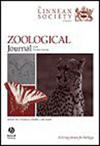Gaining and losing on the way: the evolutionary scenario of reproductive diversification in genus Urodasys (Macrodasyida: Gastrotricha) inferred by multi-gene phylogeny
IF 3
2区 生物学
Q1 ZOOLOGY
引用次数: 0
Abstract
The microscopic members of the genus Urodasys are easily recognizable due to their exceptionally long tail. There are 17 described species within this iconic genus, each distinguished by various sexual organ arrangements and reproduction modalities, including the sole known ovoviviparous gastrotrich species. The remarkable variety in reproductive characteristics has captured the interest of researchers aiming to illuminate its origin and evolution. The recent discovery of a species bearing a novel set of reproductive structures has challenged early hypotheses. However, all the evolutionary scenarios put forward need to be more convincing. To gain deeper insight into the evolutionary history of these iconic animals, we obtained the nucleotide sequence of two nuclear genes and one mitochondrial gene from species’ representatives of the four known possible combinations of the reproductive apparatus and reproduction modalities. The multi-gene data matrix was analysed phylogenetically using three approaches. The analyses yielded phylogenetic trees with invariant topology. In all cases, the specimens appear organized in four robustly supported clades and subclades that reflect their reproductive system organization. Our results suggest that the sclerotized stylet evolved inside the copulatory organ before the loss of the left testis and offers a new scenario for the evolutionary history of genus Urodasys.得失在路上:由多基因系统发育推断的腹腹蛇属生殖多样化的进化情景
由于它们特别长的尾巴,显微镜下的乌洛达斯属成员很容易辨认。在这个标志性的属中有17个被描述的物种,每个物种都以不同的性器官安排和繁殖方式来区分,包括唯一已知的卵胎生腹鸟物种。生殖特征的显著多样性引起了旨在阐明其起源和进化的研究人员的兴趣。最近发现的一种具有一套新颖生殖结构的物种挑战了早期的假设。然而,所有提出的进化设想都需要更有说服力。为了更深入地了解这些标志性动物的进化史,我们从四种已知的生殖器官和生殖方式的可能组合的物种代表中获得了两个核基因和一个线粒体基因的核苷酸序列。采用三种方法对多基因数据矩阵进行系统发育分析。分析得到具有不变拓扑结构的系统发育树。在所有情况下,标本似乎组织在四个强有力的支持枝和亚枝,反映了他们的生殖系统的组织。我们的研究结果表明,在失去左睾丸之前,硬化的柱头在交配器官内进化,并为乌洛达斯属的进化史提供了新的设想。
本文章由计算机程序翻译,如有差异,请以英文原文为准。
求助全文
约1分钟内获得全文
求助全文
来源期刊
CiteScore
6.50
自引率
10.70%
发文量
116
审稿时长
6-12 weeks
期刊介绍:
The Zoological Journal of the Linnean Society publishes papers on systematic and evolutionary zoology and comparative, functional and other studies where relevant to these areas. Studies of extinct as well as living animals are included. Reviews are also published; these may be invited by the Editorial Board, but uninvited reviews may also be considered. The Zoological Journal also has a wide circulation amongst zoologists and although narrowly specialized papers are not excluded, potential authors should bear that readership in mind.

 求助内容:
求助内容: 应助结果提醒方式:
应助结果提醒方式:


